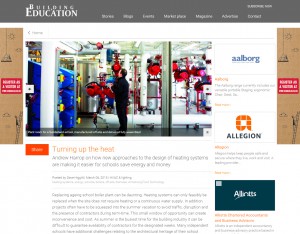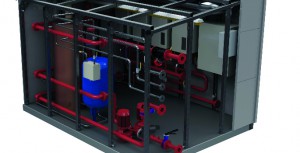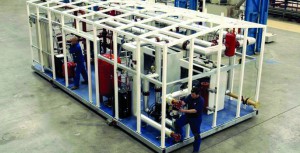As seen on b4ed.com - March 06, 2015
 Andrew Harrop on how new approaches to the design of heating systems are making it easier for schools save energy and money
Andrew Harrop on how new approaches to the design of heating systems are making it easier for schools save energy and moneyReplacing ageing school boiler plant can be daunting. Heating systems can only feasibly be replaced when the site does not require heating or a continuous water supply. In addition, projects often have to be squeezed into the summer vacation to avoid traffic, disruption and the presence of contractors during term-time. This small window of opportunity can create inconvenience and cost. As summer is the busiest time for the building industry it can be difficult to guarantee availability of contractors for the designated weeks. Many independent schools have additional challenges relating to the architectural heritage of their school buildings. Access can be problematic and something as basic as the size of doorways can present problems when removing the old boiler or positioning its replacement.
School leadership teams want to make informed decisions about the new equipment installed and need to streamline the delivery of the refurbishment project to minimise problems and delays. So what aspects of best practice can schools incorporate into their planning? What questions should school leaders ask potential suppliers?
In recent years a number of new approaches have evolved which simplify and remove risk from school boiler replacement projects. These can streamline practical aspects such as installation, access and project scheduling.
First, it can be beneficial to look for suppliers capable of rendering the proposed system design using 3D computer modelling. This enables the boiler, pumps, piping and so on to be manipulated and “connected” on screen, employing accurate dimensions for each system component. This can be an extremely valuable tool for schools where the architectural features of the site provide limitations for access or installation. Potential problems (such as mismatching of components or connections) can be addressed long before the equipment arrives on site. It can also be useful if the proposed capital investment needs to be considered by individuals who are non-technical, such as patrons, governors or financial advisers.
A school is not the ideal place to assemble boiler plant, any more than the hard shoulder is suitable for the manufacture of a car. As a result, off-site manufacture of plant rooms has emerged as a preferred approach in recent years, particularly in projects such as schools and hospitals. Instead of arriving at the site as a ‘kit of parts’, the boiler room is assembled off-site by a specialist company and delivered to the school on the specified date, requiring only positioning in place and final connections.
There are many benefits to this approach and independent research carried out by BSRIA shows that off-site manufacture can reduce the overall project cost by as much as 24 percent compared to conventional methods. First, constructing the plant room in the factory offers faster assembly, streamlined planning and peace of mind. The equipment is connected and tested prior to arriving at the site so the time required for installation and commissioning can be reduced from weeks to days, solving problems caused by time limitations. Second, manufacture of the plant room can continue independently of any constraints imposed by usage of the site (for example, assembly can continue in the factory during term-time without any impact on the school). The project is also less susceptible to costly on-site delays and bottle necks, such as the presence on site of other trades or adverse weather conditions.
Third, off-site manufacture significantly reduces health and safety risk by minimising the presence of contractors and traffic at the school. Finally, the factory environment also lends itself to stringent monitoring of quality control during the assembly process for a better final product. In summary, the greatly reduced installation times of off-site manufacture have made it perfectly possible to schedule boiler replacement projects outside the summer break.
If the positioning of boiler plant does not lend itself to the off-site manufacture of an integrated plant room, then the school may still be able to derive benefits from ‘packaged plant’. This refers to the pre-assembly/integration of key parts of the boiler plant in the factory. For example, the Armstrong Fluid Technology MBS heating solution is a fully integrated modular boiler system incorporating fully modulating boilers, variable primary pumps, automatic fill/pressurisation unit and integrated controls. It is pre-specified to automatically deliver optimum energy efficiency and pre-assembled in the factory for rapid installation on site.
It is designed in modules (which fit through a standard-sized doorway) and are quickly bolted together on site. The individual components are all integrated and tested before arriving on site, and the power and control wiring is plug and play. This significantly speeds us the boiler replacement project meaning that a system which has been purpose-designed in advance, a 320kW system, for example, can be positioned, assembled and ready for commissioning in just a few hours.
In any boiler replacement project it is important to avoid replacing like with like, as this could fail to harness important energy- and cost-saving opportunities offered by newer technologies. The system design for the replacement boiler system will depend on the existing plant, the site’s heating (or cooling) demands and the school’s sustainability ambitions. Key technologies which have proved advantageous in educational sites over recent years, however, include: low-carbon technologies; condensing boilers; variable speed pumps; relational control; renewable technologies; biomass boilers integrated with condensing boiler back-up; solar integrated with thermal store and condensing boiler back-up.
In summary, initial discussions with potential supply partners for heating system replacement projects might, therefore, address the following points:
- Will the equipment be assembled off-site and brought to the school requiring final connections? Or will contractors assemble the systems on site?
- Can the supplier render the proposed system in 3D computer modelling to anticipate and resolve potential installation problems in advance?
- What issues relating to access does the supplier anticipate? Is the proposed system designed to be modular to enable delivery through standard doorways? Or will adaptations have to be made to the school building to facilitate removal or installation of equipment?
- What level of energy- and cost-savings does the proposed replacement system offer compared to the current boiler plant?
- Does the proposed heating system incorporate technologies with proven benefits for school sites, such as variable speed pumps, condensing or biomass boilers and relational control?
- How does the supplier intend to ensure that the equipment is properly integrated, to ensure that the different components of the system work effectively together to optimise the energy-saving potential of different technologies?
Case study: two new schools in Sunderland
For the construction of two new schools, Academy 360 and Red House Academy in Sunderland, it was decided that off-site manufacture would be the best approach.
Fully integrated plant rooms were constructed at Armstrong Fluid Technology’s factory in Halesowen, West Midlands, and housed in 18m x 8m plant room enclosures. On the date required, each plant room was delivered to site fully assembled and requiring only final connections. Off-site manufacture of each plant room made it possible for construction to proceed concurrently with the rest of the project and meant that assembly could continue regardless of the weather. Carrying out this part of the project away from the construction site, in a purpose-designed factory, also reduced the health and safety risk.
At the heart of each energy centre is a 350 to 500kW biomass boiler, fuelled by wood pellets. Heat is also generated by solar panels. Armstrong variable speed booster sets and pumps distribute hot and cold water supplies throughout each site. By utilising a number of high-efficiency variable speed components and advanced controls technology, the system design ensures that energy-efficiency performance will outperform standard school HVAC installations by a significant margin throughout the equipment’s lifetime.
Andrew Harrop is technical services director of Armstrong Fluid Technology
www.armstrongfluidtechnology.com
Also seen on:
- ie-today.co.uk - March 06, 2015
- b4ed.com - March 29, 2015





